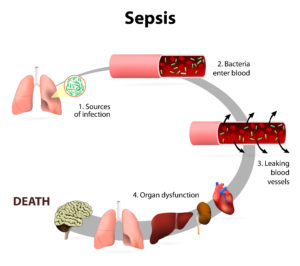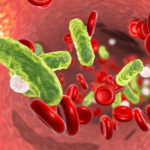Sepsis is a life-threatening condition that arises when the body’s response to infection injures its own tissues and organs. It is a rare condition that can look just like flu, gastroenteritis or a chest infection. Therefore it is essential that you know how to recognise it.
Although sepsis is often referred to as either blood poisoning or septicaemia, these terms refer to the invasion of bacteria into the bloodstream. Sepsis can affect multiple organs or the entire body even without blood poisoning or septicaemia. It can also be caused by viral or fungal infections although bacterial infections are by far the most common cause.

Statistics
There are around 120,000 cases a year in England. Around 44,000 people die every year as a result. Anyone can develop sepsis after an injury or minor infection, although some people are more vulnerable. Sepsis is also the biggest direct cause of death in UK pregnancies.
People at Risk of Sepsis
- with a medical condition or receiving medical treatment that weakens their immune system
- who are already in hospital with a serious illness
- who are very young or very old
- those who have just had surgery or who have wounds or injuries as a result of an accident
Some autoimmune and other diseases can affect the risk of contracting sepsis. These include HIV and Hepatitis C
Symptoms:
The UK Sepsis Trust has come up with a useful acronym for sepsis:
S – Slurred Speech
E – Extreme shivering or muscle pain
P – Passing no urine in a day
S – Severe breathlessness
I – “I feel like I might die”
S – Skin mottled or discoloured.
Sepsis is often diagnosed based on simple measurements such as your temperature, heart rate and breathing rate. A blood test may be required. Other tests can help determine the type of infection, where it’s located and which body functions have been affected. If detected early and hasn’t affected vital organs yet, it may be possible to treat the infection at home with antibiotics. Most people who detect it at this stage make a full recovery.
Almost all people with severe sepsis and septic shock require admission to hospital. Some people may require admission to an intensive care unit (ICU). Because of problems with vital organs, people are likely to be very ill, and the condition can be fatal. However, it is treatable if it is identified and treated quickly and in most cases leads to a full recovery with no lasting problems.
Severe sepsis and septic shock are medical emergencies. If you think you or someone in your care has one of these conditions go straight to A&E or call the Emergency Medical Services.
You can find more on the UK Sepsis Trust website at www.sepsistrust.org
For more information on training courses, visit our “Courses” page which also includes our First Responder and First Person on Scene (FPOS) Courses.


Pingback: Knife wounds can affect any part of the body and cause serious injury